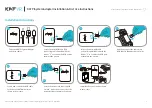
Configuring Regional Parameters and Supplementary Services
Configuring Supplementary Services (Star Codes)
Cisco SPA and Wireless IP Administration Phone Guide
157
8
You can configure one or more * codes into this parameter, such as *72, or
*72|*74|*67|*82, and so on. The maximum total length is 79 characters. When the
user has a dial tone (first or second dial tone), they can enter a * code (and the
following target number according to current dial plan) to trigger the Cisco IP
phone to call the target number prepended by the * code. For example:
a. After the user dials *72, the Cisco IP phone plays a special prompt tone while
waiting for the user the enter a target number (which is validated according to
the dial plan as in normal dialing).
b. When a complete number is entered, the Cisco IP phone sends an INVITE to
*72
target_number
as in a normal call. This feature allows the proxy to process
features such as call forward (*72) or BLock Caller ID (*67).
The * codes should not conflict with any of the other vertical service codes
internally processed by the Cisco IP phone. You can delete any * code you do not
want to SPA9000 to process.
You can add a parameter to each * code in
Features Dial Services Codes
to
indicate what tone to play after the * code is entered, such as *72‘c‘|*67‘p‘.
Following is a list of allowed dial tone parameters (note the use of back quotes
surrounding the parameter without spaces).
•
‘c‘ = Cfwd dial tone
•
‘d‘ = Dial tone
•
‘m‘ = MWI dial tone
•
‘o‘ = Outside dial tone
•
‘p‘ = Prompt dial tone
•
‘s‘ = Second dial tone
•
‘x‘ = No tones are place, x is any digit not used above
If no tone parameter is specified, the Cisco IP phone plays the prompt tone by
default.
If the * code is not to be followed by a phone number, such as *73 to cancel call
forwarding, do not include it in this parameter. In that case, add that * code in the
dial plan.















































